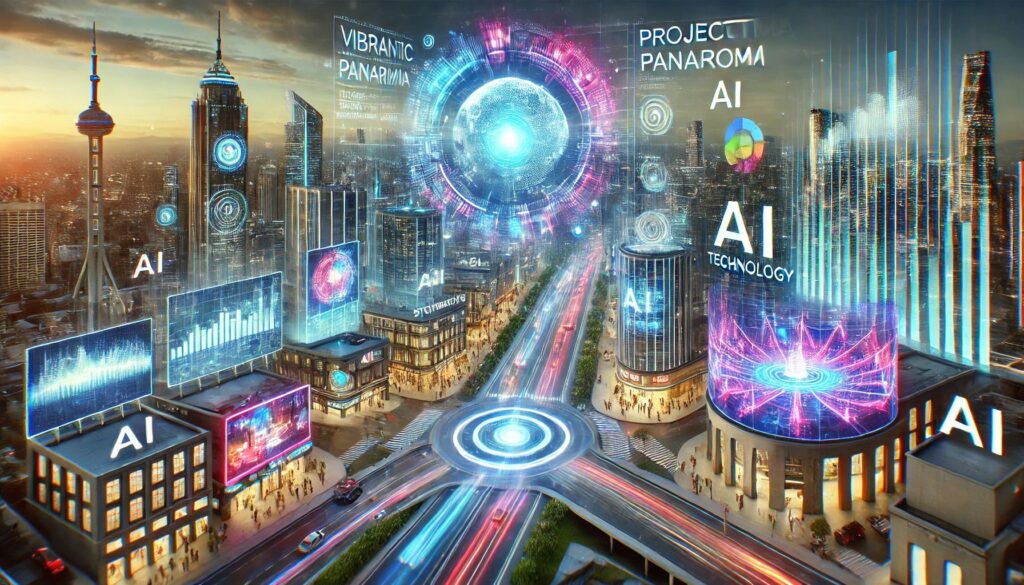
Table of Contents
Technology is evolving at an unprecedented pace, and one of the most exciting advancements is Projected Panorama AI. This emerging technology combines artificial intelligence (AI) with panoramic projections to create immersive, interactive experiences that revolutionize multiple industries. From entertainment and education to healthcare and retail, Projected Panorama AI is set to redefine how we interact with digital content.
In this blog, we’ll explore what Projected Panorama AI is, its key applications, benefits, challenges, and future potential. Whether you’re a business owner looking to leverage this innovation or a tech enthusiast eager to learn, this guide will provide you with valuable insights.
What Is Projected Panorama AI?
Projected Panorama AI is an advanced AI-powered visualization technology that combines panoramic imaging, projection mapping, and artificial intelligence to create dynamic, immersive environments. It allows users to experience 360-degree digital projections that adapt in real-time to their movements, preferences, and interactions.
Key Features of Projected Panorama AI
✔️ AI-Driven Interactivity – Uses machine learning to adjust projections based on user input.
✔️ 360-Degree Panoramic Views – Offers a fully immersive visual experience.
✔️ Real-Time Adaptability – Dynamically adjusts to environmental factors and user preferences.
✔️ Seamless AR/VR Integration – Enhances virtual reality experiences without requiring headsets.
Applications of Projected Panorama AI
The potential applications of Projected Panorama AI span multiple industries, providing innovative solutions that enhance user engagement and efficiency.
1. Entertainment and Gaming
🎮 Immersive gaming experiences – Gamers can step into a virtual world projected around them.
🎥 Next-level movie theaters – AI-powered 360-degree cinematic experiences.
🎤 Live concerts and performances – Creates dynamic and interactive stage visuals.
2. Education and Training
🏫 Virtual classrooms – Students can engage with interactive lessons projected around them.
🩺 Medical training – AI-generated 3D anatomical projections improve hands-on learning.
🏢 Corporate training simulations – Offers realistic workplace training scenarios.
3. Tourism and Real Estate
🌍 Virtual travel experiences – Explore historical sites and landmarks through immersive projections.
🏡 Real estate showrooms – Buyers can walk through projected versions of properties before they’re built.
🏛️ Museum exhibitions – Enhances historical storytelling with interactive projections.
4. Retail and Marketing
🛍️ AI-powered product displays – Creates engaging, interactive showcases for products.
🎯 Personalized shopping experiences – Adjusts advertisements and recommendations based on customer behavior.
👕 Virtual fitting rooms – Allows customers to try on clothes using AI-generated projections.
5. Healthcare
📊 Advanced medical imaging – Enhances MRI and CT scan visualization with 3D projections.
💪 Physical therapy and rehabilitation – Interactive projections assist in patient recovery exercises.
🔬 Surgical training and simulation – Provides real-time, AI-powered holographic guidance for surgeons.
Benefits of Projected Panorama AI
Adopting Projected Panorama AI offers numerous advantages for businesses, educators, healthcare professionals, and consumers.
✅ Enhanced Immersion – Creates lifelike, engaging digital experiences.
✅ Increased Engagement – Interactive elements boost user participation and learning.
✅ Cost-Effective – Reduces reliance on expensive VR headsets and other hardware.
✅ Scalability – Can be applied across various industries with customizable solutions.
✅ Seamless Integration – Works alongside AR, VR, and IoT devices for expanded functionality.
Challenges and Limitations of Projected Panorama AI
While Projected Panorama AI presents groundbreaking opportunities, there are some challenges to consider.
🚧 High Initial Costs – Developing and deploying this technology requires significant investment.
🚧 Technical Complexity – Needs advanced AI algorithms and high-quality projection systems.
🚧 Space Requirements – Requires suitable environments for large-scale projections.
🚧 Data Privacy Concerns – AI-driven personalization may raise privacy issues.
🚧 Maintenance and Calibration – Ensuring long-term functionality requires regular updates.
The Future of Projected Panorama AI
As AI and projection technologies continue to evolve, Projected Panorama AI is expected to become more accessible and powerful. Future developments may include:
🔮 AI-Driven Personalization – Systems that adapt in real-time to individual preferences.
🔮 Holographic Enhancements – The fusion of Projected Panorama AI with holographic technology.
🔮 Smart Cities Integration – AI-powered public displays for navigation and entertainment.
🔮 5G and Edge Computing Synergy – Faster data processing will enhance real-time interactivity.
With ongoing research and development, Projected Panorama AI could soon become a staple in our everyday lives, from shopping malls and classrooms to medical centers and entertainment venues.
How to Leverage Projected Panorama AI for Your Business
If you’re a business owner or innovator looking to integrate Projected Panorama AI, here’s how you can get started:
1️⃣ Identify Your Needs – Determine how AI-powered projections can enhance your business operations.
2️⃣ Invest in Scalable Technology – Choose solutions that grow with your company.
3️⃣ Collaborate with AI and Tech Experts – Work with developers and engineers to create custom applications.
4️⃣ Ensure Data Security Compliance – Implement robust cybersecurity measures to protect user data.
5️⃣ Stay Ahead of Trends – Keep up with industry advancements for continuous improvement.
Final Thoughts
Projected Panorama AI represents the next frontier in interactive technology, merging AI, projection mapping, and immersive visuals to transform industries. Whether in gaming, education, healthcare, or retail, this cutting-edge innovation is redefining how we engage with digital environments.
As technology advances, businesses and individuals who adopt Projected Panorama AI early will gain a competitive advantage, offering unparalleled user experiences. The future is bright, and this AI-powered transformation is just beginning.
FAQs
1. How is Projected Panorama AI different from VR?
Unlike VR, which requires headsets, Projected Panorama AI uses AI-driven panoramic projections to create immersive experiences without wearable devices.
2. Is Projected Panorama AI expensive to implement?
The initial investment can be high, but costs are expected to decrease as the technology matures.
3. Can small businesses use Projected Panorama AI?
Yes! Many affordable solutions are emerging, allowing businesses of all sizes to leverage interactive AI projections.
4. What industries will benefit the most from this technology?
Industries like entertainment, education, real estate, retail, and healthcare will experience the most significant impact.
5. Is Projected Panorama AI available today?
Some forms of this technology are already in use, but its full potential is still being explored. Expect rapid advancements in the coming years!
🚀 Are you ready to embrace the future of AI-driven immersive technology? Start integrating Projected Panorama AI into your business today! 🚀

Pingback: Western Times Magazine